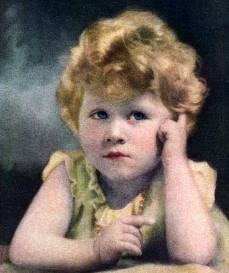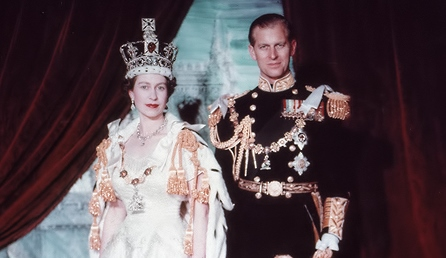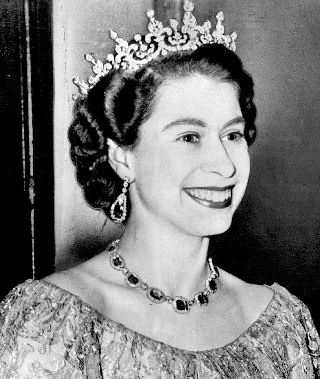Early Life, Princess, and World War II
Biography
Occupation: Queen of the United Kingdom
Reign: February 6, 1952 – present
Born: April 21, 1926 in Mayfair, London, United Kingdom
Best known for: The longest-reigning British monarch
Biography:
Queen Elizabeth II is the current queen of the United Kingdom. She has been queen since February 6, 1952, making her the longest-reigning British monarch in history. While the political landscape both in the United Kingdom and the world has undergone drastic changes during her reign, Elizabeth II has remained a popular monarch and is much beloved throughout the world.

Princess Lilibet (Source: Time Magazine Cover, April 29, 1929)
Growing Up a Princess
Elizabeth Alexandra Mary was born on April 21, 1926 at 17 Bruton Street in London, England. At the time, her grandfather King George V was King of the United Kingdom and her father was the Duke of York. This made young Elizabeth a princess. Growing up, Elizabeth went by the nickname "Lilibet."
As a princess of the United Kingdom, Elizabeth lived a pampered life. She was educated by private tutors at home and enjoyed riding horses at her family's country home in Windsor Great Park. Her younger sister, Princess Margaret, was born in 1930 and her family was close. However, Elizabeth was not a spoiled child. Many adults who came into contact with her commented on how mature and grounded she was even at a young age.
Heir to the Throne
Everything changed for Elizabeth in 1936. First, her beloved grandfather, King George V, died and her uncle became King Edward VIII. Elizabeth was now second in line to the throne after her father. However, it wasn't really expected that she would be queen. Her uncle Edward would likely have children and one of them would assume the crown. Then, the truly unexpected happened. King Edward abdicated the crown and her father became king. Now Elizabeth was next in line to the throne.
As the future queen, life for ten-year-old Elizabeth took a dramatic turn. She now had to prepare to lead the country and her every move was chronicled and scrutinized by the public and the press. Young Elizabeth dealt with the pressure expertly. She had grown up with a strong sense of duty and had a strong bond with her parents to fall back on when needed.
World War II, Marriage, and Children
The years between becoming the heir apparent to the throne and becoming Queen were marked by three major events: World War II, her marriage, and the birth of her first two children.
When World War II began in 1939, it was suggested that the Queen, Elizabeth's mother, flee England and go to Canada. However, her mother refused to leave the king. Elizabeth, along with her sister and mother, did leave the city of London, however. They spent much of the war at Windsor Castle. Elizabeth gave her first radio broadcast in 1940 on the BBC's Children's Hour. She also took an honorary position in the Auxiliary Territorial Service (the women's branch of the British Army) where she trained as a mechanic and driver.
Elizabeth was eight years old when she first met her future husband Prince Phillip of Greece and Denmark. She was only thirteen when she proclaimed she had fallen in love with him. The two began to exchange letters and later began to court in secret as they didn't want the press to be hounding them. They announced their engagement in July of 1947 and were married in Westminster Abbey on November 20, 1947. Their wedding was an international event with millions of people listening to the BBC broadcast around the world. The young married couple had their first child, Prince Charles, around a year later. They would go on to have a total of four children: Charles, Anne, Andrew, and Edward.

Queen Elizabeth II and Prince Philip, Duke of Edinburgh Author: Cecil Beaton
Becoming Queen

Queen Elizabeth II in Royal Dress in 1953 Source: Associated Press
In the early 1950's, Elizabeth's father became ill with lung cancer. As his condition worsened, Elizabeth was forced to take on some of the duties of the British Monarch. In 1952, she was visiting Kenya while filling in for her father on a state visit when she got the news that her father had passed. On February 6, 1952 Elizabeth acceded to the throne as Queen of the United Kingdom and all the Commonwealth's realms.
After assuming the role of Monarch, Elizabeth headed home to meet with Winston Churchill, the current British Prime Minister. She chose the regnal name of Elizabeth and would be known as Elizabeth II. After a year of mourning for her father, her coronation occurred on June 2, 1953. Elizabeth's coronation was a massive affair and was televised worldwide in 39 different languages.
Family Life
Elizabeth was still a young lady of 25 years when she was crowned queen. She had a husband and two young children. She would go on to have two more children while queen. She dearly loved her husband and family life was important to her. As one might expect, it was nearly impossible to have a "normal" family life as Queen of Britain, but Elizabeth did her best. Today (as of 2019), she is still married to Prince Philip (Duke of Edinburgh) and has eight grandchildren and eight great-grandchildren.
Political Involvement
While the Queen is technically the Head of State of the British government, she seldom gets involved in politics. Queen Elizabeth II has been very careful throughout her reign to stay out of politics and little is actually known about her political views. Early in her reign, she appointed the Prime Minister to form a government from the Conservative party. Her first appointment was Harold Macmillan in 1957 and the second was Alec Douglas-Home in 1963. In later years, the political parties adopted their own ways to select the Prime Minister.
Despite not being directly involved in politics from a public standpoint, Queen Elizabeth meets with the Prime Minister once a week. During these audiences, the Prime Minister updates the queen on government issues and matters of state. In the early part of her reign, Prime Ministers such as Winston Churchill offered advice to the young queen. Today, the Queen likely can offer advice to the Prime Minister from her years of experience. As Prime Minister David Cameron once said, she has "literally heard it all before."
Traveling the World
Throughout her reign, Queen Elizabeth II has traveled the world extensively. She is one of the most widely traveled heads of state in world history and has visited over 130 countries. In the 1970's she was particularly busy when she took 73 trips and visited 48 different countries. The country she has visited the most is Canada.
What kind of queen is Queen Elizabeth II?
Despite her long reign and many years in the public eye, little is known about the personal feelings or politics of the Queen. She rarely gives interviews and is very formal when in public. One thing we do know; she is fully committed to the duties of her position. She has always worked hard to represent her country and the royal family in the best way possible.
Elizabeth's private interests include horses, dogs (particularly Welsh Corgis), and Scottish country dancing. She began riding horses at the age of six and became an accomplished rider by her teens. She took a strong interest in breeding horses and owning racing thoroughbred horses. Her love for corgis started when she was a young girl and continues to this day. Three of her corgis (Monty, Willow, and Holly) appeared with James Bond in the opening ceremony of the 2012 Olympics.
Interesting Facts about Queen Elizabeth II
She is currently (as of 2019) Commander-in-Chief of the British Armed Forces and the Canadian Armed Forces.
Besides being Queen of the United Kingdom, she is also queen of many other countries: Canada, Jamaica, New Zealand, Australia, the Bahamas, and Barbados; just to name a few.
One of her favorite hobbies is photography.
In 2017, she celebrated her 65th year as Queen with a Sapphire Jubilee. She is the first British monarch to have a Sapphire Jubilee.
Her nickname "Lilibet" comes from her own pronunciation of "Elizabeth" when she was a child.
She was educated by tutors at home. In order for her to socialize with other girls her age she joined the Girl Guides (like the girl scouts). Her patrol leader, Patricia Mountbatten, was the first cousin of Elizabeth's future husband.
She speaks fluid French.
She is allowed to drive in the United Kingdom without a license.
Elizabeth and her sister Margaret joined the massive crowds in the streets celebrating the end of World War II.
Although she was born on April 11, the country celebrates her birthday on June 11th. This way the weather is more likely to be better for a parade.
When Tony Blair became the British Prime Minister in 1997, he became the first prime minister born during Queen Elizabeth II's reign.
She loves dogs and has owned over 30 Welsh Corgis during her reign.
Answer these questions:
How old is Queen Elizabeth II?
How many years has Queen Elizabeth II been in reign?
Why did Elizabeth become queen when at first she was second in line to the throne?
Who is the first prime minister born during Queen Elizabeth II's reign?
Where did the Queen spend most of her time during World War II?
How old has the Queen been in love and how many years has she been married to Prince Phillip?
In what year did the Queen and Prince Phillip have their first child?
How many children do the Queen and Prince Phillip have in total?
What activities does the Queen have a strong interest in?
How do the Queen and Prime Minister work?

